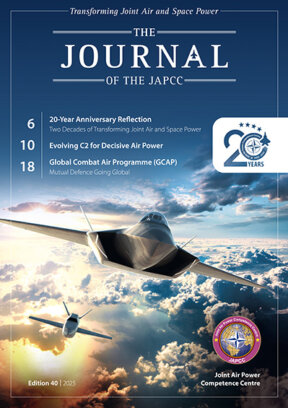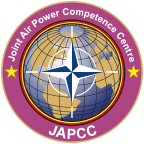Introduction
Competent air controllers are essential for effective air power, especially as global security deteriorates and air battle management becomes more complex. However, the training process has several challenges, both in training structure and personnel management.1 Modern air operations involve rapid information flow and sophisticated threats, meaning training methods must keep up. This paper examines these challenges, with a focus on air battle manager (ABM) training. It also explores how artificial intelligence (AI)-driven support systems can help improve traditional training, benefiting both students and instructors. Challenges inherent in international training environments, such as cultural, language, and logistical differences, underscore the need for more adaptive and reliable training solutions.
This analysis will first outline what an effective training framework looks like. Then, it will examine common problems, such as system failures and insufficient resources. After that, it will introduce and evaluate an AI-driven training solution, looking at its technical characteristics, why it works from a teaching perspective, and its practical benefits. The discussion will use historical examples and recent case studies. Finally, the conclusion will emphasize that AI-supported ABM training is a viable and effective means to support, but not replace, human instructors, helping to create a stronger and more efficient training program.
The Landscape of Air Controller Training: Frameworks and Fissures
A sound training system for air controllers needs clear goals, defined prerequisite skills, and organized timelines. It also needs objective standards for judging student performance.2 While designing a whole program is a big topic, this analysis focuses on the basic ‘101 level’ of air controller training.
The support needed for this kind of training is significant. It includes dedicated courses, qualified instructors, advanced simulators (and the technicians to run them), training facilities, and extensive information technology (IT) systems. The reliability of all this is key, but it is often a weak point. Still, the people – instructors and support staff – are the real backbone of these operations. Most air control training programs are currently split into academic, simulation, and live training phases. These often happen in order, with classroom learning before practical exercises, but this can change based on the course and the student’s background. For example, there are faster options for experienced personnel.
Even with careful planning, training systems, especially complex simulators, can face severe disruptions. Hardware or software failures, which can sometimes affect multiple connected systems, can cause long delays and create scheduling headaches, even if backup systems are in place. Upgrades or major maintenance work can also reduce simulator availability, often clashing with existing training schedules and affecting how quickly groups of students can progress. Sometimes, simulators are in different buildings, making access difficult, depending on whether the system is working and if an instructor is available.
The Human Element: Instructor Burden and Resource Allocation
A common problem in military training is that there are often too many students for each instructor due to limitations within the organization. Instructors frequently have many duties beyond just teaching, such as administrative work, developing course materials, scheduling, and keeping up their own operational qualifications.3 Juggling all these tasks can be very demanding. In multinational units, these problems are even bigger. International students might need extra help with language, adjusting to different teaching styles, adapting to a new culture, and making practical arrangements. They often turn to instructors for this help, which takes away time from core teaching duties and gives individual attention to students.
While instructors usually accept these extra duties as part of the job, splitting their time inevitably means less time for preparing and delivering training, which is problematic when it comes to repetition-based learning environments like ABM training.4 No matter how basic, every training exercise needs an instructor, a simulator, and simulator operators. When this practice is interrupted – because of system problems, an unavailable instructor, or scheduling conflicts – students can go for long periods without practical experience. These gaps are particularly hard on less experienced trainees, especially those working in a language that is not their own. This can lead to skills fading, feeling overwhelmed in high-pressure live situations, and, in the worst cases, failing missions or dropping out of training. The resulting instructor fatigue and burnout can also lower the overall quality and effectiveness of the training program.
AI-Driven Training Systems: A Scalable Solution
To tackle these many challenges, NATO needs scalable solutions that directly help students learn while reducing the load on instructors. One promising idea is using laptop-based, AI-driven training platforms that can work with any Command and Control (C2) system.
System Architecture and Capabilities: Such a system, which can be considered an interactive simulator, lets student controllers practice basic air control scenarios (like simple two versus two non-manoeuvring engagements) independently. The teaching approach is a mix of machine learning (ML) and other AI techniques. Key parts include:
- Intelligent Tutoring System (ITS): The ITS gives real-time, relevant feedback while running a scenario. This feedback can appear as text on the screen or as a synthesized voice, using different ways to help students learn. An ITS usually includes a domain model (with expert knowledge of air control procedures), a student model (which tracks individual progress, common mistakes, and likely knowledge gaps based on performance), and a pedagogical model (which decides the best way and time to offer help).5 How well the pedagogical model works is key to making sure feedback is helpful and not excessive.
- Adaptive Difficulty Engine: ML algorithms can change how complex a scenario is in real time based on how the student is doing. This ensures the challenge keeps the student in their ‘zone of proximal development’.6 This might mean changing the number of aircraft, how they move, weather conditions, communication demands, or adding unexpected events, all of which help students become more adaptable and better problem-solvers.
- Multimodal Input and Cognitive State Assessment: Using eye-tracking technology allows the system to monitor where students look (such as their scan patterns and how long they look at certain things) and physical signs of mental effort, like pupil dilation. Combined with voice analysis (e.g. speech rate, hesitations, and clarity) through speech-interactive avatars, the system can assess a student’s stress and cognitive overload levels, prompting assistance from the ITS or changes to the scenario’s difficulty.
- Portability and Accessibility: Because the system runs on regular laptops with standard equipment like headsets and footswitches, training can happen in many places – classrooms, remote locations, or even at home. Cloud-based user profiles help track progress and let instructors see student performance data remotely, allowing for more specific feedback and support, and creating a more continuous learning experience.
As to educational rationale and benefits, adaptive and AI-driven learning approaches work based on well-known learning principles. When students can practice deliberately, repeating scenarios at their own speed, they develop automatic skills and muscle memory for complex procedures.7 The immediate, personalized feedback from the ITS fits with ideas of active learning and learning from mistakes, helping students understand and correct errors faster. By delegating basic, repetitive tasks, instructors can use their expertise for more complex scenarios, one-on-one mentoring, and advanced teaching. Also, because basic air control procedures are unclassified, scenarios can be run in a ‘mission-unspecified’ way, avoiding security issues tied to classified simulators.
Empirical Support and Case Study Analysis
The potential benefits of these AI-supported systems are not only theoretical. Past training disruptions and recent evaluations provide strong evidence.
- Operation Allied Force (Kosovo, 1999): When NATO halted basic AWACS controller training for a month due to operational needs, it created a huge training backlog that took almost two years to clear. An accessible, AI-driven system could have let student controllers keep practicing and improving their procedural skills during this time, reducing the backlog. For example, if students had about six hours of training per day, they could have accomplished around thirty AI-driven missions per day. Over twenty duty days (four weeks), that is six hundred missions, helping them maintain necessary learning momentum.
- NATO AWACS Midterm Upgrade (2006–2008): The major system changes during this fleet upgrade suddenly created separate training paths and a need to retrain existing personnel, overwhelming simulator availability and instructor resources. A portable AI system could have offered a flexible way to practice standard procedures relevant to the old and new systems. It could also have helped new students learn basic control concepts before approaching high-demand simulators.
- Air National Guard (ANG) Evaluation (2022): A competition involving ANG Battle Control Centres used an AI-supported system as a case study. Airmen controlled 336 missions, getting 65 man-hours of training value. Achieving the same training output with a standard simulator and its support staff would likely have taken an estimated 756 man-hours. This data suggests a potential twelve-fold increase in training efficiency for the scenarios tested. It highlights significant potential cost-savings in man-hours and the ability to train more people.
These examples show how AI-driven systems can help keep training going during disruptions, manage sudden increases in training demand, and make better use of training resources.
Discussion and Future Directions
Using AI-driven training systems represents a significant shift in tackling long-standing air controller training problems. The main benefit is in supporting human instructors, not replacing them. These systems can make quality procedural practice more widely available, reduce instructor burnout from repetitive basic tasks, and provide rich data for tracking student progress and finding areas where training could be improved.
However, putting these systems into place does have its challenges. Developing AI models that are effective training aids requires a lot of upfront investment in expertise and testing.8 It is vital to ensure that AI-generated feedback helps students perform better in complex, real-world situations. Various ethical concerns must be mitigated, especially around data privacy and the chance of AI assessment bias. Future research should continue to examine AI’s effectiveness in training and explore how training aids can be combined with live missions and high-fidelity simulation training. Additionally, there is work to be done to create more advanced, adaptive scenarios that enhance complex thinking skills like high-pressure decision-making and crewmember teamwork. As a potential avenue of future work, JAPCC might explore how AI can be used to develop more complex teams and multi-agency collaborations.
Conclusion
AI-driven training solutions, like portable, adaptive platforms with ITS features, offer a powerful way to make air controller training programs more efficient, accessible, and robust. By allowing self-directed, repetitive practice in a controlled setting, these systems can improve student results, lessen instructor workload, and ensure training can continue even with logistical or resource problems. For organizations that want to stay at the forefront of air power, using these kinds of technological innovations is not just helpful – it is becoming essential for preparing controllers for the complexities of modern operations.











